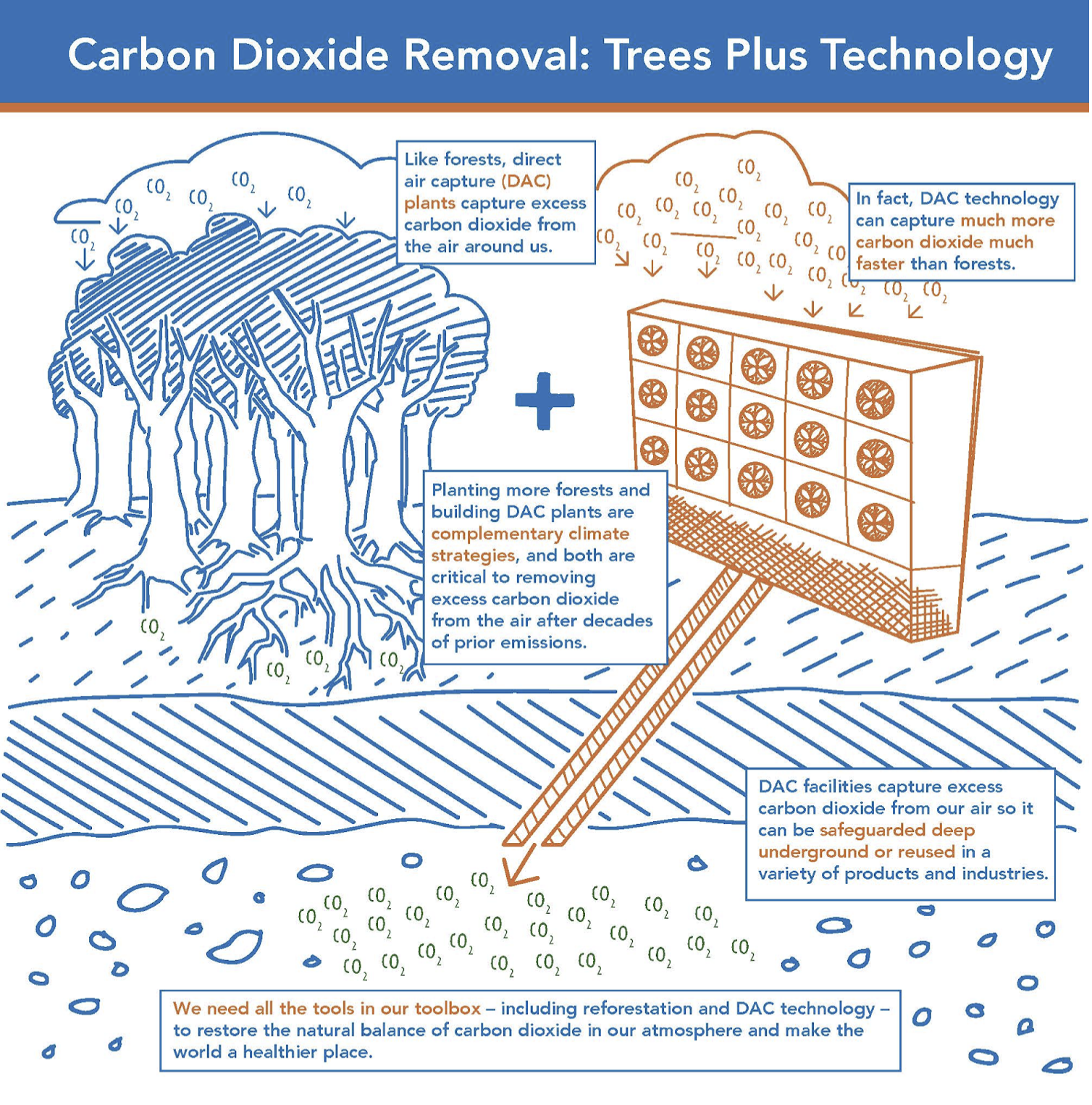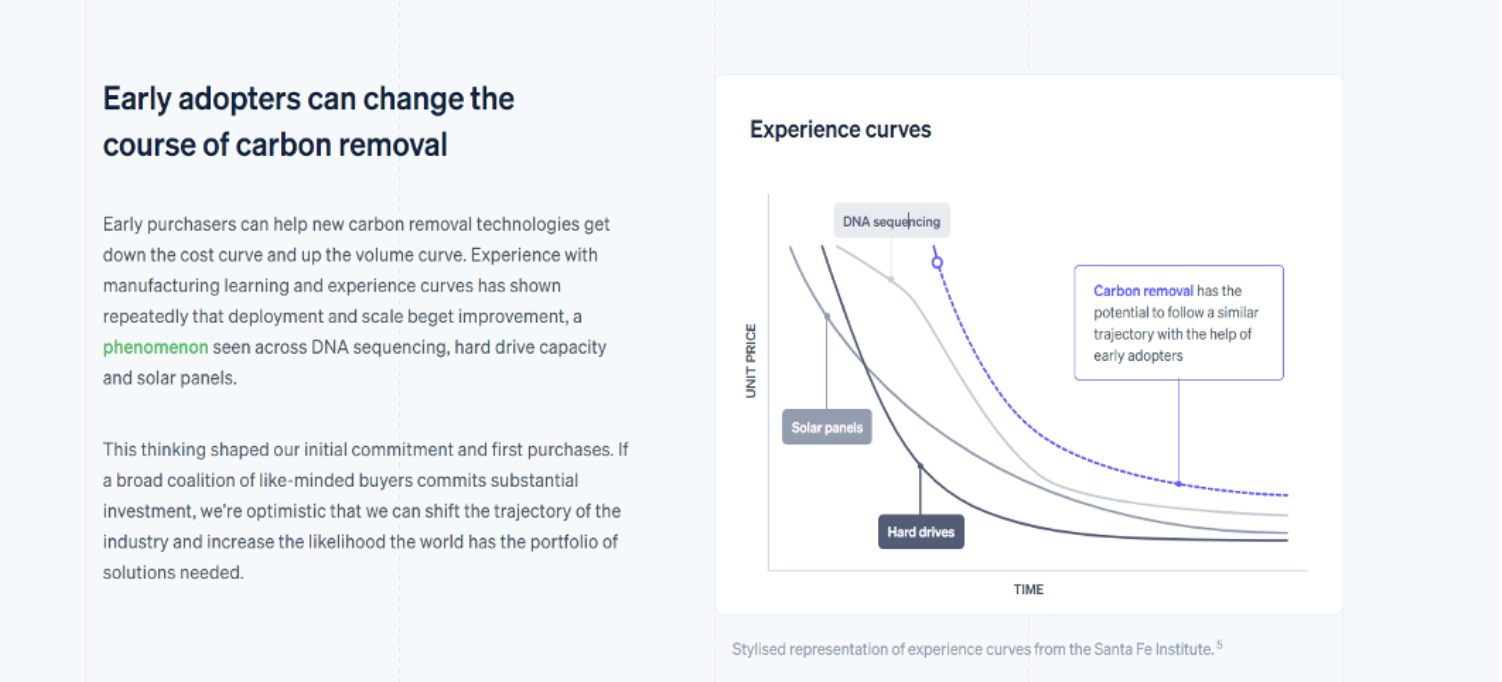Science and Technology (What Is It)
What is Direct Air Capture?
Direct Air Capture (DAC) is a type of technology that removes carbon dioxide from the air. Sometimes referred to as a Negative Emissions Technology (NET), direct air capture (DAC) systems extract CO2 directly from the ambient atmosphere. The CO2 can be permanently stored in deep geological formations (thereby achieving negative emissions or carbon removal), utilized for long-lived durable products such as building materials, used in food and beverage processing, or combined with hydrogen to produce synthetic fuels.1
How is The Technology Deployed?

Several companies have begun deploying various types of DAC technology and significant R&D efforts are underway to continue improving effectiveness. Additional approaches being explored for capturing CO2 from air include passive systems, membrane systems, electrochemical systems, refrigeration systems, and more. DAC is an active area of scientific and engineering research, and new methods are rapidly emerging.
What Can We Do With The Captured CO2?
The two primary uses for captured CO2 are underground sequestration and utilization for goods or industrial processes.
CO2 sequestration removes the CO2 from the atmosphere permanently, but relies on government or sponsor funding as it does not generate an otherwise usable product. Two common forms of geological sequestration are mineralization in underground rock formations and storage in saline reservoirs. CO2 utilization is already core to many industrial processes and the number of applications for air-sourced CO2 is growing rapidly.
What is The Current Global Market Size for Commercial CO2?
The merchant market for CO2 today is roughly 180 million tons per year.3 Innovators are developing ways that air-sourced CO2 can be used as an additive by beverage companies, upcycled into chemicals and advanced materials like carbon nanotubes, and injected into concrete to make it stronger.4 Other entrepreneurial efforts are also creating economical ways of transforming CO2 into advanced fuels that can power cars, ships, or even aircraft and rockets. The total available market for carbontech products has been estimated at over $1 trillion.5
DAC’s Role in Addressing Climate Change (Why Do We Need It)
How Much Carbon Removal Do We Need Over Time?
Estimates from the IPCC suggest that 100 – 1,000 billion metric tons (Gigatons or Gt) of carbon dioxide removal will be needed over the 21st century for the world to limit global warming to 1.5 degrees Celsius (2.7 degrees Fahrenheit) above pre-industrial levels (identified as a critical target threshold under the 2015 Paris Agreement). Extensive analysis has found that scenarios achieving 1.5°C included carbon removal deployment by 2050 ranging from 1.3 to 29 gigatons of CO2 removal per year, with most falling between 5 and 15 gigatons. This massive level of carbon dioxide removal is in addition to the very aggressive measures we need to take to reduce humanity’s ongoing carbon dioxide emissions through the widespread adoption of renewable energy and many other emissions reduction measures.
What is the Current Capacity of Existing DAC Technology?
According to the IEA, currently 19 direct air capture (DAC) plants are operating worldwide, capturing more than 10,000 tons of CO2/year (approx. 2,000 passenger vehicles). Current technologies have been limited by high costs (several hundred dollars per ton of CO2 removed) and substantial energy requirements (more than 7 gigajoules, or GJ, of energy per ton of CO2).6
Is Carbon Removal a Substitute for Reducing Emissions?
No.
Given the amount of CO2 in the atmosphere today, reducing emissions and removing carbon dioxide from the air are necessary and complementary strategies which are both needed to avert the worst impacts of climate change.
What Other Carbon Removal Solutions Exist Besides DAC?
Direct Air Capture is just one of several carbon removal methods being developed. Other potential solutions range from technological approaches like Bioenergy Carbon Capture and Storage (BECCS) to biological and nature-based approaches like reforestation, soil carbon sequestration, and engineered wood, as well as geological approaches like enhanced weathering and seawater carbon sequestration, among others.7
How is Direct Air Capture (DAC) Different from Point Source Carbon Capture and Storage (CCS)?

Carbon Capture and Storage (CCS) involves capturing CO2 at emissions sources such as cement plants or power plant smokestacks, preventing its release into the atmosphere by directly capturing it. By contrast, Direct Air Capture involves the removal of CO2 that has already been emitted directly from ambient air.
CCS is a method of emissions reductions while DAC is a method of permanent carbon removal.10
What Economic Opportunities Does DAC Create?
At full scale deployment, DAC is expected to generate between 600,000 to 1.35 million high-wage jobs by 2050 in the United States alone. Breaking this estimate down, a typical 1 megaton capacity DAC plant can generate roughly 3,500 jobs across the DAC supply chain. The sectors that would benefit most from these new jobs include construction, engineering and equipment manufacturing that could see a minimum of 300,000 new jobs. Whereas, the cement and steel employment could increase by 50%; operation and maintenance as well as chemical and natural gas workers would see major new job growth opportunities.11
Does DAC Encourage Continued Reliance on Fossil Energy?
Some are concerned that DAC and other NETs will serve as a convenient excuse to continue burning fossil fuels, commonly referred to as the “moral hazard” problem. However, the fact is that BOTH emissions reductions via rapid decarbonization and shift to cleaner sources of power AND excess carbon dioxide removal are needed at massive scale to meet international climate goals. To hit these targets, global society does not have the luxury of treating it as an either/or situation, rather it requires a both/and inclusive approach to reducing current carbon emissions and removing legacy CO2 emissions to return atmospheric CO2 to safe levels.
Who is Developing DAC Technology?
Check out our DAC Directory to see some of the leading innovators in the field!
If you have any feedback on the content above, please Contact Us. For further DAC-related resources, please see our Information Toolkit, Report Library and News pages.



